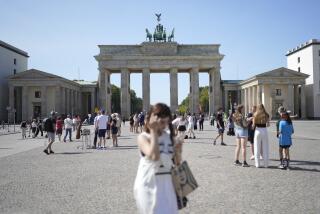‘The Fence Is Down and We’re Free’--Border Towns Begin Bridging Germanys : Reunification: Excited locals see the first signs of the East-West merger in through traffic and shared shopping centers.
- Share via
DOEMITZ, East Germany — As policy makers debate how German unity might come about, the small Elbe River town of Doemitz has already made unification a fast-unfolding reality.
The land mines along the border and the death strip that formed part of Europe’s East-West divide and kept two generations of locals from getting even a decent look at the river have been dismantled.
A ferry, leased by the neighboring West German authorities across the river, once again links Doemitz with the Elbe’s west bank. Work is scheduled to start later this year to rebuild the bridge just north of town that was destroyed by low-flying American bombers in the final days of World War II.
Representatives from the West German Plus and REWE supermarket chains have been through, and town officials now talk of transforming an abandoned munitions factory site into a Western-backed commercial district.
“If we don’t move fast, events will pass us by,” explained the town’s affable mayor, Helmut Geschwentner. “There’s a lot of work to do.”
In this once-bustling river port of 3,500, it is easy to feel the powerful sense of release from an unhappy past and an urgency to make up for lost time. A similar mood in other East and West German communities is helping to drive the two Germanys toward each other far faster than expected.
No negotiations are needed here, no formal accords. In Doemitz, unity means through traffic and a shopping center.
“We feel we’re in the middle of Europe again,” said Wolfgang Nowe, an instructor at an agricultural college.
But the political change has also brought an emotional roller coaster. On the December morning that ferry service began, the town was on such a high that the local school principal simply dismissed classes and urged his excited pupils to go and watch.
A month later, the mood darkened when the young Communist mayor, Geschwentner’s predecessor, had a nervous breakdown and resigned. He had defied regional party discipline to approve the ferry service, and among his critics in the party hierarchy was his own father.
In February, three full months after East Germany’s neo-Stalinist regime collapsed, residents learned of a secret-police safe house in their midst that no one in the close-knit community admits to knowing existed. Since then, rumors have bubbled that three or four residents worked as informants, but so far there is no proof.
The wounds of a divisive election campaign and nagging doubts about the future also have sobered those basking in the glow of their new freedom. A similar malaise has unsettled many of East Germany’s 16 million people and has led to the curious mixture of hope and concern about the future that now grips the country. An eagerness to end this uncertainty with swift unification is seen as a key reason for the surprising success of the conservative Christian Democrats in East Germany’s first free elections last weekend.
Many here are still trying to get over the shock of viewing their town for the first time from the West German side of the Elbe.
“We never knew how fenced in we were,” a secretary in the mayor’s office said.
Added Nowe, “It was a crushing experience to look back at that fence; it was something to be ashamed of. People are still trying to work through what has happened.”
There is also a sense of disillusionment that prominent figures who served the Communist order, such as judges and public prosecutors, remain in place. Residents say that even those few party officials who have been arrested still receive full pay.
“It’s like de-Nazification, where we saw all those people get their jobs back,” Nowe said.
Despite these concerns, however, optimism here overrides doubt. West German economists believe border towns such as Doemitz will be among the first East German communities to reap the economic benefits of unification if residents are prepared to commute.
One resident noted that her son, a draftsman, soon would have the choice of keeping his current salary of $220 per month or going across the river to earn nine times that much doing the same job.
“Commuting could be a very important issue,” said Norbert Walter, chief economist of West Germany’s largest bank, the Deutsche Bank.
The quiet suspicion that greeted a foreign visitor to Doemitz last summer has been swept away by the change, replaced instead by smiles and jokes about becoming accustomed to traffic noise.
“It may not be as peaceful, but we’re just happy the fence is down and we’re free,” retired shop assistant Ritte Wilkens said.
Amid this freedom, the process of knitting East and West Germany together goes on.
Residents talk of Hamburg once again becoming the nearest city for big shopping trips, of re-establishing ties with Dannenberg across the river and of school visits to far-off places.
Six of the 10 cars in the Town Hall parking lot on a recent day carried West German license plates, and West German tourists stroll around with cameras, some returning for the first time since the 1930s.
Six small, state-owned building industry enterprises have restructured themselves as a single public company and already are taking delivery of materials, apparently on credit, from a family-owned West German firm.
According to Mayor Geschwentner, that family holds the original title to the property on which the six enterprises sit.
“This just happened last week,” he said with a smile. “In five years, we’ll be prosperous. We’ll have the bridge. Then we’ll be as we were.”
More to Read
Sign up for Essential California
The most important California stories and recommendations in your inbox every morning.
You may occasionally receive promotional content from the Los Angeles Times.













